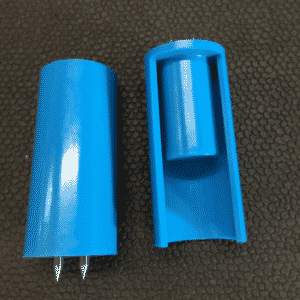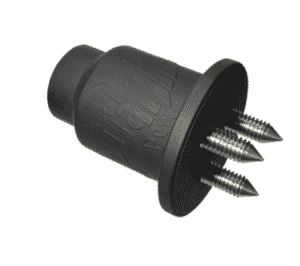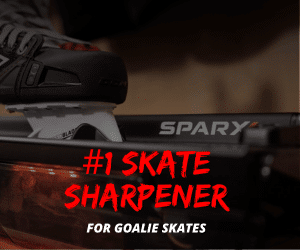Ever wonder why nets at a high level stick so well?
Here’s a hint: they’re not using a standard goal net peg.
There are a couple things you should keep in mind when purchasing new pegs for your hockey net. If you’re buying pegs for your own personal use, you’re going to look at things differently than a rink and vice versa
Let’s get into the process.
How to choose the right hockey net pegs (and what options are available)
When it comes to goal net pegs (also known as net moorings), there isn’t a massive selection available. It’s also important to note that there are different applications for each peg and peg combination.
First, we’ve got traditional net pegs.

Traditional net pegs come dislodged easily (since you’re re-creating the lodging prior to every use) and chew up the area in which they’re set when used for prolonged periods of time.
So, any time you use these pegs for a practice, the net gets bumped in to time and time again and you’re constantly making the hole they sit in larger. This in turn makes the net easier to move and we go on and on.
Second, Marsh pegs.

This peg system is actually one of the more effective and useful net mooring system there is, but it’s pretty hard to maintain.
Every time you have to set nets, a rink attendant has to drain the marsh peg hole and set the net. In addition, you’ve got to maintain drilled holes in the ice and the list goes on.
Marsh pegs, while they are incredibly effective and used at the highest level of play, just do not cut it for the standard rink.
So what net peg options are available to the everyday consumer?
You could purchase standard net pegs. They actually do the job quite well, they’re the cheapest of any available option and they’re pretty safe (the net is easily dislodged).
Have you ever heard of Quik Anchor Pegs?
If you haven’t yet heard of the product, get used to it.
Quik Anchor Pegs are one of the top available options to consumers for use in both game and practice play. There are two different options available, the Game Ready Adjustable peg and the Guardian Anchor Peg.
The NAHL uses the Game Ready Adjustable peg, in addition to a few other leagues.
Here are the pegs in action.
Anchor Pegs come in two different models, both adjustable.
First, Game Ready Adjustable pegs.

These pegs sell for $140 (per pair, one pair is enough for one net).
Each net peg is fully adjustable, as you can see in the photo attached here. The Quik Anchor Peg “Adjustable” version was one of the very first of it’s kind on the market, and today it has very little competition.
As you can probably imagine, the net peg market is not that competitive. For any serious rink, the biggest deciding factor in this peg is that it’s fully adjustable.
Buy Game Ready Adjustable Goal Net Pegs
Second, Guardian Anchor Pegs (practice net pegs)

Goalies love these pegs for a couple of reasons. First, they protect the edges of their skates while holding down the net at the same time.
On that same note, the net simply does not move.
The only difference between these and the adjustable pegs are the additional post protector addition. Of course, they are not suitable for game play.
Quik Anchor pegs come with replacement screws and protector covers.
Finally, Piranha Pegs.

First, you’ll notice a slightly shorter peg. This design feature is that so in the event of a collision with the net, the net itself becomes dislodged easier.
Second, three spikes (non adjustable). Personally, I have not tested the three spike design, though, it would seem three spikes are better than two.
The biggest downside of the Piranha peg is that the spikes are not adjustable. The biggest upside is three spikes and a shorter profile.
There are plenty of great hockey net peg options available to the every day consumer
There are hundreds of high level hockey teams changing from the traditional net pegs to options like the Quik Anchor Pegs and the Piranha pegs.
As little as 3 years ago, this was unheard of. Rinks were concerned with nets sticking or ice being damaged with anchor pegs. Being adjustable, this is no longer an issue.
These net pegs are just as safe as traditional pegs and they consistently outperform their predecessors. If you’re thinking of buying new net pegs for your rink, consider a more modern option.







